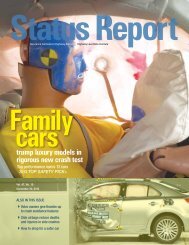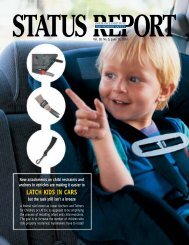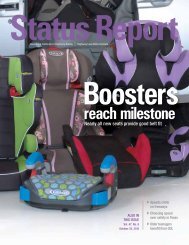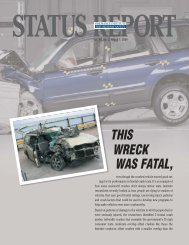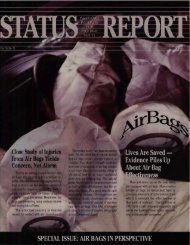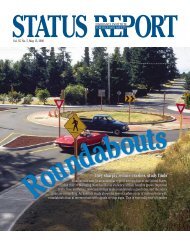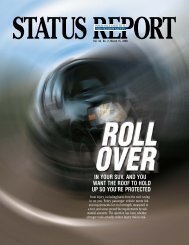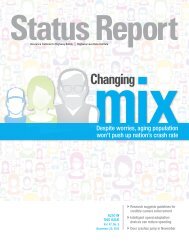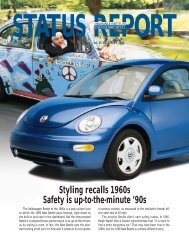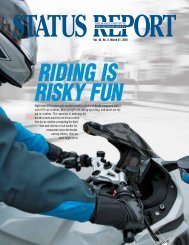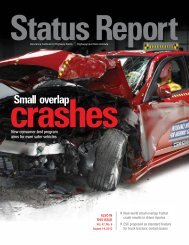IIHS Status Report, Vol. 45, No. 1, February 6, 2010 - Insurance ...
IIHS Status Report, Vol. 45, No. 1, February 6, 2010 - Insurance ...
IIHS Status Report, Vol. 45, No. 1, February 6, 2010 - Insurance ...
- No tags were found...
Create successful ePaper yourself
Turn your PDF publications into a flip-book with our unique Google optimized e-Paper software.
<strong>Vol</strong>. <strong>45</strong>, <strong>No</strong>. 1, Feb. 6, <strong>2010</strong><br />
airbags have<br />
evolved<br />
to do a better job of protecting people in multiple kinds of<br />
crashes, and each generation has done a better job of this<br />
than the one before. That is, until now. A new Institute study<br />
suggests that frontal airbags designed to meet the latest federal<br />
standards haven’t improved protection of adults and, in<br />
fact, appear to have reduced protection of belted drivers.<br />
“The newest airbags appear to provide suboptimal protection<br />
for drivers who buckle up compared with the airbags that preceded<br />
them,” says Institute president Adrian Lund. “It’s a surprising<br />
finding. Based on our analysis of death rates in frontal crashes, belted<br />
drivers seem to fare better in vehicles that have many of the advanced
2 <strong>Status</strong> <strong>Report</strong>, <strong>Vol</strong>. <strong>45</strong>, <strong>No</strong>. 1, Feb. 6, <strong>2010</strong><br />
features of current systems but weren’t certified<br />
to the latest airbag safety standard.”<br />
Together with safety belts, airbags are the<br />
cornerstone of protection in frontal crashes.<br />
Ones to safeguard drivers and front-seat passengers<br />
have been standard in all passenger<br />
vehicles since 1999. They’ve saved more than<br />
28,000 lives, the National Highway Traffic Safety<br />
Administration (NHTSA) estimates.<br />
A big difference between today’s airbags<br />
and first-generation ones is that they deploy<br />
with less force. Problems cropped up with<br />
the first generation of airbags in the mid-<br />
1990s. During crashes they were inflating<br />
with such force that they killed or seriously<br />
injured some children, small-stature adults,<br />
and other people who were too close to the<br />
bag when it inflated (see <strong>Status</strong> <strong>Report</strong>, June<br />
17, 2000; on the web at iihs.org). NHTSA<br />
attributes 296 deaths to frontal airbags, including<br />
191 children, 92 drivers, and 13<br />
adult passengers as of Jan. 1, 2009. Nearly 90<br />
percent of deaths occurred in vehicles made<br />
before 1998 when the agency first changed<br />
frontal crash safety standards in ways that<br />
promoted less forceful deployments.<br />
“Early airbags as opposed to crash forces<br />
were the source of injury in some cases,”<br />
Lund explains. “They saved many lives but<br />
at the same time put some vulnerable passengers<br />
at risk. When it became clear what<br />
was happening, NHTSA allowed automakers<br />
to redesign airbags, and once the fixes were<br />
in place, deaths dropped sharply.”<br />
Steps to address injuries: As a first step<br />
NHTSA modified safety rules in 1997 to encourage<br />
automakers to take energy out of<br />
the airbags. Depowering began with 1998<br />
models. Manufacturers were given the option<br />
to use sled tests with unbelted dummies<br />
to certify that their vehicles met crash<br />
performance rules. Or they could continue<br />
to run barrier tests with both belted and<br />
unbelted dummies.<br />
Most manufacturers picked sled tests, in<br />
which a whole or partial vehicle is attached<br />
to a moving platform that simulates vehicle<br />
crash decelerations and mimics the forces<br />
on occupants during crashes. The maximum<br />
sled accelerations NHTSA prescribed<br />
under this option were lower than typically<br />
occur in crash tests so airbags didn’t<br />
need to deploy as quickly or<br />
forcefully to catch and<br />
cushion unbelted<br />
dummies. Airbags<br />
meeting<br />
this
<strong>Status</strong> <strong>Report</strong>, <strong>Vol</strong>. <strong>45</strong>, <strong>No</strong>. 1, Feb. 6, <strong>2010</strong> 3<br />
standard are called sled-certified. The Institute<br />
previously examined the impact<br />
of NHTSA’s move to allow depowering<br />
and found an overall reduction in fatal<br />
crash risk associated with depowered<br />
airbags compared with earlier designs<br />
(see <strong>Status</strong> <strong>Report</strong>, March 6, 2004; on the<br />
web at iihs.org).<br />
Other research has shown that the fatality<br />
risk among children in front seats<br />
decreased with sled-certified airbags (see<br />
<strong>Status</strong> <strong>Report</strong>, June 9, 2008; on the web at<br />
iihs.org). At the same time a large-scale<br />
public education campaign encouraged<br />
parents to restrain children, especially infants<br />
in rear-facing restraints, in the back<br />
seat, where they’re safest. Legislators in<br />
many states enacted laws requiring children<br />
to sit in the rear. Parents largely got<br />
the message.<br />
Today most kids ride restrained in<br />
back seats. These and other changes<br />
plus increasing belt use have contributed<br />
to the drastic decline in frontal airbagrelated<br />
deaths, the bulk of which occurred<br />
in vehicles made before 1998 (see<br />
<strong>Status</strong> <strong>Report</strong>, Aug. 1, 2004, and Aug. 6,<br />
2005; on the web at iihs.org).<br />
Tailored deployment: The sled test<br />
option was meant to be a stopgap until<br />
NHTSA could write a new standard to explicitly<br />
address airbag-induced<br />
injuries while also improving<br />
protection for a range of<br />
different-size people in various<br />
frontal crashes. During<br />
2001 the agency issued a<br />
certified advanced airbag<br />
rule, with phase-in beginning<br />
with 2003 models.<br />
Advanced airbags modify<br />
deployment patterns if<br />
weight sensors detect a small<br />
front-seat driver or passenger<br />
or a child safety seat. These<br />
airbags can be suppressed<br />
altogether or deploy with less<br />
force when passengers are small<br />
or out of position or if a crash isn’t<br />
severe. They also can determine if<br />
occupants’ safety belts are buckled.<br />
Certified-advanced airbags generally deploy<br />
at lower thresholds for people who<br />
aren’t using belts.<br />
This changed the way auto manufacturers<br />
test vehicles for compliance. It introduced<br />
a range of tests, including headon<br />
and offset frontal crash tests plus<br />
out-of-position tests of airbags using different-size<br />
dummies. For the first time,<br />
the automakers were directed to use<br />
dummies representing 5th percentile females<br />
and children 1, 3, and 6 years old,<br />
in addition to the standard 50th percentile<br />
male dummy.<br />
Crash test speeds also changed. For<br />
belted male dummies, the rule phased in<br />
a 5 mph speed increase, to 35 mph, beginning<br />
with 2007 model vehicles. Rigid-barrier<br />
tests for unbelted occupants were<br />
reinstated, but the crash test speed was<br />
lowered from 30 mph to 25 mph (see <strong>Status</strong><br />
<strong>Report</strong>, June 17, 2000; on the web at<br />
iihs.org).<br />
Anticipating the design changes that<br />
an advanced airbag standard would require,<br />
some automakers added new features<br />
ahead of the rule. These included<br />
dual-stage inflators, belt status sensors,<br />
seat position sensors, and occupant size<br />
and weight sensors. Some new airbag<br />
systems also had sensors to detect rearfacing<br />
infant restraints in front seats and<br />
prevent airbags from deploying. Many of<br />
these systems closely resemble certifiedadvanced<br />
airbags.<br />
“The advanced features automakers<br />
added changed the game,” Lund says.<br />
“Instead of tailoring protection and deployment<br />
for one group — average-size<br />
men in a typical crash — manufacturers<br />
were able to design airbag systems to<br />
provide better protection for a range of<br />
people in a variety of crash situations.”<br />
What the changes mean: What hadn’t<br />
been known is how advanced airbags<br />
compare with the previous designs. To<br />
find out, Institute researchers recently<br />
compared mortality rates in frontal crashes<br />
among front-seat occupants in vehicles<br />
with certified-advanced airbags —<br />
the latest generation (continues on p.6)<br />
1.0<br />
0.8<br />
0.6<br />
0.4<br />
0.2<br />
adjusted mortality rate ratios of<br />
drivers and adult right-front passengers<br />
drivers<br />
right-front<br />
passengers<br />
Sled/advanced vs.<br />
sled/not advanced<br />
Certified-advanced vs.<br />
sled/advanced<br />
BELTED DRIVERS HAVE<br />
HIGHER mortality RATES<br />
IN VEHICLES MEETING THE<br />
ADVANCED AIRBAG RULE<br />
Compared WITH drivers<br />
WHOSE AIRBAGS HAVE<br />
ADVANCED FEATURES BUT<br />
AREN’T CERTIFIED TO THE<br />
LATEST SAFETY STANDARD.
4 <strong>Status</strong> <strong>Report</strong>, <strong>Vol</strong>. <strong>45</strong>, <strong>No</strong>. 1, Feb. 6, <strong>2010</strong><br />
DRINKING Continues<br />
TO DECLINE AMONG<br />
WEEKEND DRIVERS<br />
Alcohol use by nighttime drivers on weekends<br />
is down sharply since 1973 but remains a major<br />
problem in fatal crashes. The latest national<br />
roadside breath-test survey indicates 2.2 percent<br />
of drivers had blood alcohol concentrations<br />
(BACs) of 0.08 percent or more in 2007,<br />
marking a 71 percent decline from 1973 when<br />
the first survey was conducted. At the same<br />
time, 16 percent of nighttime weekend drivers<br />
tested positive for drugs, the National Highway<br />
Traffic Safety Administration (NHTSA) says.<br />
The agency cautions that its first-ever estimate<br />
of driver drug use doesn’t necessarily imply<br />
that these drivers were impaired.<br />
The percentage of alcohol-impaired nighttime<br />
drivers in 2007 compares with 4.3 percent<br />
in 1996, 5.4 percent in 1986, and 7.5 percent in<br />
1973. There were similar declines during the<br />
same period in the percentages of drivers with<br />
any detectable alcohol in their systems.<br />
The 2007 survey involved randomly stopping<br />
drivers at 300 locations in 48 states on<br />
Friday and Saturday nights and during the day<br />
on Fridays. The daytime component was new<br />
for 2007, along with drug screens, and for the<br />
first time the survey included motorcycles.<br />
Drivers were more likely to be impaired by<br />
alcohol between 1 and 3 am (4.8 percent) than<br />
during the daytime (0.2 percent) or early evening<br />
(1.2 percent). This is in line with federal<br />
data showing that alcohol involvement in fatal<br />
crashes peaks at night and is higher on weekends.<br />
All 50 states and the District of Columbia<br />
have per se laws defining it as a crime for people<br />
to drive with a BAC at or above a proscribed<br />
level, 0.08 percent.<br />
“The roadside surveys suggest that the<br />
prevalence of alcohol-impaired driving has<br />
gone down over time, and that’s great news,”<br />
says Anne McCartt, Institute senior vice president<br />
for research. “Fatal crashes tell a different<br />
story. The reductions aren’t showing up in federal<br />
crash data. We can’t explain the disconnect,<br />
so this merits more research.”<br />
Based on fatal crash data, the proportion of<br />
fatally injured drivers with BACs at or above<br />
0.08 percent declined by about a third between<br />
1982 and 1994, from 49 percent to 33 percent.<br />
Since 1994 the percentage of fatally injured<br />
nighttime drivers with BACs at or above 0.08<br />
percent has remained about a third. Likewise,<br />
the percentage of fatally injured drivers with<br />
0.15 percent or higher BACs has slid 30 percent<br />
since 1982 but with little change since 1996.<br />
A complication in the latest roadside survey<br />
may be that drivers were less willing to<br />
participate in 2007 than in years past. NHTSA<br />
notes that the 85 percent participation rate<br />
was lower than the 96 percent recorded in 1996<br />
and 94 percent recorded in 1986. This might<br />
reflect driver concerns about litigation and privacy<br />
rights. It also might reflect a general reluctance<br />
to be interviewed. NHTSA accounted for<br />
this by using passive alcohol sensors to estimate<br />
refusers’ BACs.<br />
Surveyed male drivers were more likely to<br />
have illegal BACs than females (2.6 percent<br />
versus 1.5 percent). Compared with 1996, a<br />
lower percentage of males had illegal BACs in<br />
2007 (3.5 percent in 1996). The percentage of<br />
female drivers with illegal BACs didn’t change<br />
between 1996 and 2007. Fatal crashes among<br />
male drivers are much more likely to involve<br />
alcohol than those among females.<br />
Motorcycle riders in the 2007 survey were<br />
more than twice as likely as car drivers to have<br />
BACs at or above 0.08 percent (5.6 versus 2.3<br />
percent), followed by pickup truck drivers (3.3<br />
percent). However, crash data indicate that alcohol<br />
is a bigger factor in passenger vehicle driver<br />
deaths. Thirty-five percent of fatally injured passenger<br />
vehicle drivers versus 30 percent of cyclists<br />
had BACs of 0.08 percent or more in 2008.<br />
Drivers were asked to complete a questionnaire<br />
to estimate the prevalence of binge drinking,<br />
defined as consuming 6 or more drinks on a<br />
single occasion at least monthly, and heavy<br />
drinking, defined as 5 or more drinks a day 4 or<br />
more times a week. About 26 percent of drivers<br />
said they don’t drink.<br />
Binge drinking was widely reported by<br />
nighttime drivers with high BACs. Among people<br />
who said they drink, about 19 percent met<br />
the criteria for heavy drinking and 18 percent
<strong>Status</strong> <strong>Report</strong>, <strong>Vol</strong>. <strong>45</strong>, <strong>No</strong>. 1, Feb. 6, <strong>2010</strong> 5<br />
for bingeing. These two groups accounted<br />
for the largest percentage of drivers with<br />
positive BAC results in the roadside survey.<br />
Since this questionnaire was new for 2007<br />
NHTSA can’t compare responses with prior<br />
surveys. The agency says the results suggest<br />
the need to focus on binge drinkers<br />
6<br />
through tougher enforcement of DUI/DWI<br />
laws and prevention programs.<br />
“Another option is requiring alcohol detection<br />
devices for all drivers once the tech-<br />
6 4<br />
nology is fully developed,” McCartt says. The<br />
devices would prevent any driver from starting<br />
a vehicle after drinking too much. This<br />
4 2<br />
idea has strong public support (see <strong>Status</strong> <strong>Report</strong>,<br />
Sept. 17, 2009; on the web at iihs.org).<br />
2 Car Minivan Motorcycle Pickup SUV<br />
Previous roadside surveys estimated only<br />
alcohol use, but NHTSA expanded testing in<br />
2007 to include screening of saliva and blood<br />
samples Car for Minivan over-the-counter, Motorcycle Pickup prescription, SUV<br />
and illegal drugs. More nighttime than daytime<br />
drivers tested positive (14 versus 11 percent).<br />
The drugs most often detected were<br />
marijuana (8.3 percent), cocaine (3.9 percent),<br />
and methamphetamine (1.3 percent).<br />
It’s difficult to tell whether the drivers<br />
were impaired by the drugs because some<br />
drugs can be detected in the body weeks after<br />
use. Also unclear is the dose at which<br />
driving is impaired. NHTSA is conducting<br />
more research to understand the impact of<br />
drug use on highway safety, including which<br />
drugs impair driving ability and at what<br />
dose levels and which drugs are linked to<br />
higher crash rates.<br />
Access “2007 national roadside survey of<br />
alcohol and drug use: alcohol prevalence<br />
rates” and “2007 national roadside survey of<br />
alcohol and drug use: drug prevalence<br />
rates” at www.nhtsa.dot.gov.<br />
30<br />
50<br />
20<br />
40<br />
10<br />
30<br />
20<br />
10<br />
50<br />
percent of fatally injured drivers with bacS<br />
at or above specified thresholds, 1982-2008<br />
40<br />
0.08%<br />
0.15%<br />
0.08%<br />
0.15%<br />
1982 85 90 95 2000 05<br />
1982 85 90 95 2000 05<br />
4<br />
8<br />
2<br />
6<br />
4<br />
8<br />
6<br />
percent of weekend nighttime<br />
drivers with bacS 0.08 or more<br />
1973 1986 1996 2007<br />
The percentage of impaired nighttime<br />
drivers in the 2007 roadside survey<br />
was 2.2 percent. This compares with 4.3<br />
percent in 1996, 5.4 percent in 1986, and<br />
7.5 percent in 1973. There were similar<br />
declines in percentages of drivers with<br />
any detectable alcohol in their systems<br />
during the same period. Drivers with<br />
BACs of 0.15 percent or more accounted<br />
for 0.4 percent of all drivers in 2007<br />
versus 0.6 percent in 1996, 1 percent<br />
in 1986, and 1.4 percent in 1973.<br />
2
Nhtsa examines fatal crash factors<br />
Airbags and safety belts vastly improve occupant protection, yet thousands of people die in frontal<br />
crashes each year. A federal study of the factors behind these deaths suggests the need for improved<br />
vehicle designs and advanced restraints to better protect people in corner and oblique<br />
crashes, impacts with narrow objects like poles, and underrides with large trucks and trailers. The<br />
findings are in line with Institute research.<br />
Last year the Institute combed federal crash data to explore why crash deaths and serious injuries<br />
happen in vehicles that earn good ratings based on frontal tests and suggested crash types for<br />
further analysis (see <strong>Status</strong> <strong>Report</strong>, March 7, 2009; on the web at iihs.org). Similarly, a research team<br />
from the National Highway Traffic Safety Administration reviewed every crash in which a belted<br />
driver or right front-seat passenger died in a model year 2000 or newer vehicle to obtain a sample of<br />
121 crashes to study. Data are from the Crashworthiness Data System of the National Automotive<br />
Sampling System.<br />
While the Institute looked at deaths and serious injuries, limiting cases to vehicles with good<br />
crash test ratings, the federal researchers focused on fatalities and didn’t put any conditions on test<br />
performance. The agency’s results skew toward 2000-03 models, and the Institute’s work focuses on<br />
2004-06 models with more crashworthy designs.<br />
Just over half of the people who died were in exceedingly severe crashes or had physical conditions<br />
that may have raised their injury risk. Being elderly or obese were common factors.<br />
The next most common factor involved vehicle structures that didn’t line up well enough to absorb<br />
crash energy, resulting in lots of occupant compartment intrusion. This was the case in corner<br />
crashes, impacts with poles and trees, underrides, and crashes with an oblique impact direction.<br />
Access “Fatalities in frontal crashes despite seat belts and airbags” at www-nrd.nhtsa.dot.gov/<br />
Pubs/811102.PDF. Access “A study of the factors affecting fatalities of airbag and belt-restrained occupants<br />
in frontal crashes” by R.W. Rudd et al. at www-nrd.nhtsa.dot.gov/database/nrd-01/esv/<br />
asp/esvpdf.asp.<br />
(continued from p.3) of airbags — with<br />
sled-certified ones with advanced features.<br />
They also looked at mortality<br />
among front-seat occupants of vehicles<br />
with sled-certified airbags with advanced<br />
features versus those without<br />
advanced features. The researchers<br />
analyzed the effects of airbag design<br />
changes by driver age, gender, and<br />
belt use. They also looked at mortality<br />
rates for children in front seats. The<br />
study included 1998-2006 model vehicles<br />
in crashes during 2004-07.<br />
Some people were benefiting from<br />
advanced airbag features even before<br />
airbags were certified as advanced. Mortality<br />
rates were 16 percent lower for<br />
drivers of vehicles with sled-certified airbags<br />
with advanced features than for<br />
people who drove vehicles with sledcertified<br />
airbags without advanced features.<br />
The benefit was 17 percent for<br />
adults riding in front passenger seats.<br />
Death rates were lower for both male<br />
and female drivers ages 15-59, as well as<br />
for men older than 60. Unbelted male<br />
drivers had a 38 percent lower death<br />
rate in vehicles with sled-certified airbags<br />
with advanced features compared<br />
with vehicles with sled-certified<br />
airbags lacking such features.<br />
Results for certified-advanced airbags<br />
don’t follow the same pattern. Although<br />
children benefited from both<br />
kinds of advanced airbag systems, drivers<br />
didn’t. People who drove vehicles<br />
with certified-advanced airbags had a<br />
higher mortality rate than drivers of<br />
vehicles equipped with sled-certified<br />
airbags with advanced features.<br />
Belted drivers had the biggest uptick<br />
in the risk of death — 21 percent<br />
— compared with drivers of vehicles<br />
with sled-certified airbags with advanced<br />
features.<br />
“This finding puzzles us because<br />
these drivers had otherwise done everything<br />
right in terms of buckling<br />
up,” Lund says. “It suggests there<br />
might be potential problems with the<br />
way manufacturers are required to
certify airbags as advanced because<br />
the technology introduced in vehicles<br />
during the sled test era seems to work.<br />
But when the new standard is fully in<br />
effect we don’t see an improvement.”<br />
The agency’s 2001 decision to reintroduce<br />
a rigid-barrier crash test for<br />
unbelted occupants was controversial.<br />
Automakers contended the unbelted<br />
test would prompt a return to overly<br />
aggressive airbags. The Institute initially<br />
objected to reinstating the unbelted<br />
barrier test, while other safety<br />
groups favored it (see <strong>Status</strong> <strong>Report</strong>,<br />
Oct. 9, 1998, and Feb. 6, 1999; on the<br />
web at iihs.org).<br />
The maximum test speed sparked<br />
debate, too. NHTSA at first proposed<br />
30 mph but settled on 25 mph in the<br />
final rule, a change the Institute supported<br />
(see <strong>Status</strong> <strong>Report</strong>, March 15,<br />
2003; on the web at iihs.org). Some<br />
safety groups, however, feared 25 mph<br />
would provide inadequate protection<br />
for large occupants, particularly unbelted<br />
men. Public Citizen and the Center<br />
for Auto Safety sued NHTSA, but a federal<br />
appeals court upheld the agency<br />
(see <strong>Status</strong> <strong>Report</strong>, Aug. 1, 2004; on the<br />
web at iihs.org).<br />
“Automakers may have had a point,”<br />
Lund concedes. “Airbags may be too aggressive<br />
because of the rigid-barrier test<br />
requirements for unbelted dummies. It’s<br />
also possible that advanced deployment<br />
algorithms result in some airbags<br />
not deploying at all when they would be<br />
beneficial. NHTSA needs to look at our<br />
study and try to understand if the new<br />
standard missed the mark on striking a<br />
balance between protection for both<br />
belted and unbelted occupants. In particular,<br />
belted drivers aren’t reaping the<br />
benefits we expected.”<br />
For a copy of “How have changes in<br />
airbag designs affected frontal crash<br />
mortality” by E.R. Braver et al., write<br />
Publications, <strong>Insurance</strong> Institute for Highway<br />
Safety, 1005 <strong>No</strong>rth Glebe Road,<br />
Arlington, Va. 22201, or email publications@iihs.org.<br />
new safety ratings for small pickups<br />
The Nissan Frontier has the strongest roof and the Chevrolet Colorado the weakest among five <strong>2010</strong><br />
small pickup trucks the Institute recently evaluated for occupant protection in rollover crashes. The<br />
Frontier, which also is sold as the Suzuki Equator, is the only pickup in the group to earn the highest<br />
rating of good. The Ford Ranger is rated acceptable while the Dodge Dakota, Toyota Tacoma, and<br />
Colorado, which also is sold as the GMC Canyon, earn the second lowest rating of marginal. Go to<br />
iihs.org for full results.<br />
The rating system is based on Institute research showing that occupants in rollover crashes<br />
benefit from stronger roofs (see <strong>Status</strong> <strong>Report</strong>, March 24, 2009; on the web at iihs.org). Vehicles that<br />
earn good ratings must have roofs that are more than twice as strong as the minimum required by<br />
the current federal safety standard. As a<br />
group, small pickups aren’t performing as well<br />
as small cars or small SUVs.<br />
“It’s harder to find a small pickup truck that<br />
performs well in all of our crashworthiness<br />
evaluations,” says Institute senior vice president<br />
David Zuby. In fact, no small pickup earns<br />
the Institute’s TOP SAFETY PICK award.<br />
The Institute also conducted new side impact<br />
tests of small pickups. Earning good ratings<br />
are the Frontier with standard front and<br />
rear head curtain airbags and the Ranger with<br />
standard front-seat mounted combination head<br />
and torso airbags. Also rated good is the Tacoma.<br />
In contrast, the Colorado is rated poor<br />
for side protection.<br />
roof strength<br />
GOOD<br />
ACCEPTABLE<br />
MARGINAL<br />
MARGINAL<br />
MARGINAL<br />
Nissan Frontier<br />
suzuki equator<br />
ford ranger<br />
dodge dakota<br />
toyota tacoma<br />
chevrolet colorado<br />
gmc canyon
1005 N. Glebe Rd., Arlington, VA 22201<br />
Phone 703/247-1500 Fax 247-1588<br />
Internet: www.iihs.org<br />
<strong>Vol</strong>. <strong>45</strong>, <strong>No</strong>. 1, Feb. 6, <strong>2010</strong><br />
Frontal airbags designed to meet the latest federal<br />
standards appear to have reduced protection<br />
for belted drivers in front crashes ...............................1<br />
Alcohol use is down sharply among nighttime<br />
drivers on weekends, but impairment remains a<br />
big problem in fatal crashes ....................................4<br />
People still die in frontal crashes because of personal<br />
factors like advanced age and vehicle factors<br />
like structures that don’t do a good job of managing<br />
crash energy, NHTSA says .................................6<br />
Institute rates small pickups for rollover and side<br />
impact crash protection ..........................................7<br />
Contents may be republished with attribution.<br />
This publication is printed on recycled paper.<br />
The <strong>Insurance</strong> Institute for Highway Safety is a<br />
nonprofit scientific and educational organization<br />
dedicated to reducing deaths, injuries, and property<br />
damage from crashes on the nation’s highways.<br />
The Institute is wholly supported by auto insurers:<br />
21st Century <strong>Insurance</strong><br />
AAA Mid-Atlantic <strong>Insurance</strong> Group<br />
AAA <strong>No</strong>rthern California, Nevada, and Utah<br />
Affirmative <strong>Insurance</strong><br />
Agency <strong>Insurance</strong> Company of Maryland<br />
Alfa Alliance <strong>Insurance</strong> Corporation<br />
Alfa <strong>Insurance</strong><br />
Allstate <strong>Insurance</strong> Group<br />
American Family Mutual <strong>Insurance</strong><br />
American National Property and Casualty Company<br />
Ameriprise Auto & Home<br />
Amica Mutual <strong>Insurance</strong> Company<br />
Auto Club Group<br />
Auto Club South <strong>Insurance</strong> Company<br />
Bituminous <strong>Insurance</strong> Companies<br />
Bristol West <strong>Insurance</strong> Group<br />
Brotherhood Mutual <strong>Insurance</strong> Company<br />
California Casualty<br />
Capital <strong>Insurance</strong> Group<br />
Chubb Group of <strong>Insurance</strong> Companies<br />
Concord Group <strong>Insurance</strong> Companies<br />
Cotton States <strong>Insurance</strong><br />
COUNTRY Financial<br />
Discovery <strong>Insurance</strong> Company<br />
Erie <strong>Insurance</strong> Group<br />
Esurance<br />
Farm Bureau Financial Services<br />
Farm Bureau Mutual <strong>Insurance</strong> Company of Idaho<br />
Farmers <strong>Insurance</strong> Group of Companies<br />
Farmers Mutual of Nebraska<br />
Fireman’s Fund <strong>Insurance</strong> Company<br />
First Acceptance Corporation<br />
Florida Farm Bureau <strong>Insurance</strong> Companies<br />
Frankenmuth <strong>Insurance</strong><br />
Gainsco <strong>Insurance</strong><br />
GEICO Group<br />
Georgia Farm Bureau Mutual <strong>Insurance</strong> Company<br />
GMAC <strong>Insurance</strong><br />
Grange <strong>Insurance</strong><br />
Hanover <strong>Insurance</strong> Group<br />
The Hartford<br />
Haulers <strong>Insurance</strong> Company, Inc.<br />
High Point <strong>Insurance</strong> Group<br />
Homeowners of America <strong>Insurance</strong> Company<br />
ICW Group<br />
Kemper, A Unitrin Business<br />
Kentucky Farm Bureau <strong>Insurance</strong><br />
Liberty Mutual<br />
Markel Corporation<br />
Mercury <strong>Insurance</strong> Group<br />
MetLife Auto & Home<br />
Michigan Farm Bureau <strong>Insurance</strong><br />
Michigan <strong>Insurance</strong> Company<br />
MiddleOak<br />
MMG <strong>Insurance</strong><br />
Mutual of Enumclaw <strong>Insurance</strong> Company<br />
Nationwide<br />
NLC <strong>Insurance</strong> Companies, Inc.<br />
<strong>No</strong>dak Mutual <strong>Insurance</strong> Company<br />
<strong>No</strong>rfolk & Dedham Group<br />
<strong>No</strong>rth Carolina Farm Bureau Mutual <strong>Insurance</strong> Company<br />
Oklahoma Farm Bureau Mutual <strong>Insurance</strong> Company<br />
Old American County Mutual Fire <strong>Insurance</strong><br />
OneBeacon <strong>Insurance</strong><br />
Oregon Mutual <strong>Insurance</strong><br />
Palisades <strong>Insurance</strong><br />
Pekin <strong>Insurance</strong><br />
PEMCO <strong>Insurance</strong><br />
The Progressive Corporation<br />
Response <strong>Insurance</strong><br />
Rockingham Group<br />
Safeco <strong>Insurance</strong><br />
Samsung Fire & Marine <strong>Insurance</strong> Company<br />
SECURA <strong>Insurance</strong><br />
Sentry <strong>Insurance</strong><br />
Shelter <strong>Insurance</strong><br />
Sompo Japan <strong>Insurance</strong> Company of America<br />
South Carolina Farm Bureau Mutual <strong>Insurance</strong> Company<br />
State Auto <strong>Insurance</strong> Companies<br />
State Farm<br />
Tennessee Farmers Mutual <strong>Insurance</strong> Company<br />
Tokio Marine Nichido<br />
The Travelers Companies<br />
Unitrin<br />
USAA<br />
Virginia Farm Bureau Mutual <strong>Insurance</strong><br />
West Bend Mutual <strong>Insurance</strong> Company<br />
Zurich <strong>No</strong>rth America<br />
FUNDING ASSOCIATIONS<br />
American <strong>Insurance</strong> Association<br />
National Association of Mutual <strong>Insurance</strong> Companies<br />
Property Casualty Insurers Association of America



